Optimizing the Abandonment of a Technological Innovation
Abstract
:1. Introduction
- Question #1: What is the probabilistic optimal point of abandoning an incumbent technological innovation, assuming reinvestment (transitioning from an incumbent to a new candidate), if the incumbent technological innovation’s diffusion rate is known, but the candidate technological innovation’s diffusion rate is unknown?
- Question #2: What is the probabilistic optimal point of abandoning an incumbent technological innovation, assuming reinvestment (transitioning from an incumbent to a new candidate), if both the incumbent and candidate technological innovations’ diffusion rates are unknown?
2. Background
2.1. Abandonment, Obsolescence, and Withdrawal
2.2. Innovation Diffusion Model
2.3. Economic Measure
3. Research Methodology
3.1. Simulation Setup
3.1.1. The Abandonment Event Form
3.1.2. Technological Innovation Diffusion Rate Bounding Range and Probability
3.1.3. Time-Based Economical Measure
3.2. Simulation Execution
4. Results
4.1. Deterministic Simulation Results
4.2. Stochastic Simulation—Series Event Variant #1 (Representing Question #1) Results
4.3. Stochastic Simulation—Series Event Variant #2 (Representing Question #2) Results
5. Discussion of Results
5.1. Deterministic Simulation Discussion
5.2. Stochastic Simulation—Series Event Variant #1 (Representing Question #1) Discussion
5.3. Stochastic Simulation—Series Event Variant #2 (Representing Question #2) Discussion
5.4. Assumptions and Limitations
- (1)
- All models used herein, including the diffusion model represented by the logistic model, are simplified representations of the real world. Rarely does raw diffusion data precisely align to a diffusion model. The power of a diffusion model lies in its proven ability to aid and enable the efficient generation of representative information to allow decision-makers and researchers to interpret data easily and identify patterns in that data [15,36,60,61,62,63,64]. As mentioned previously, the adaptability, simplicity, and informative nature of the logistic model were well-suited for macro-based studies.
- (2)
- The probability distribution model used was derived from US technological innovation data. It has been demonstrated in other research that innovation diffusion can be affected by region. The expansion and merit of this research to other regions were out of the scope of this effort, but it warrants study in future research. The accuracy of the distribution model used should also be acknowledged, for it was developed to obtain macro-based insights. Its absolute accuracy was not required for this effort because macro-based results were sought that were not definitive but rather associative and directional by definition. Nevertheless, examining the impact of error in the probability distribution model of diffusion rates warrants future study.
- (3)
- In defining and optimizing the series event, several conditions were established, as listed in Table 1. Although this effort justified each condition, variations of these warrant future examination.
- (4)
- The optimization of diffusion abandonment for this effort assumed that both the incumbent and candidate market values were equal. This study assumed that a decision-maker would want to invest, at a minimum, in a candidate technological innovation with a market value similar to the incumbent. Extension of the abandonment optimization model to examine technological innovations of unequal value also warrants future investigation. In addition, the results obtained in this effort are macro-based and not definitive but are instead starting points, associative and directional in nature.
5.5. Practitioner Implications and Significance
5.5.1. Proactive Abandonment Decisions
5.5.2. Complexity Reduction and Decision Speed
5.5.3. Systems Thinking
6. Conclusions
- (1)
- In situ innovation diffusion rate forecasting. The primary objective of this research endeavor would be to outline the components required to develop a framework for determining how accurately a technological innovation’s diffusion rate can be forecast with partial diffusion data. It is easy for an organization to determine a technological innovation’s diffusion rate in hindsight, but post-situ-based decision-making often leads to reactive rather than proactive action. A framework for gaining in situ knowledge about a technological innovation’s diffusion rate would benefit an organization’s decision-makers in proactively setting strategy, policy, and resource management.
- (2)
- Extension of the abandonment optimization model to examine the impact of the incumbent and candidate lifecycle overlap. The primary objective of this research endeavor would be to expand the abandonment optimization model by exploring and introducing a variable to represent the overlap of an incumbent and candidate lifecycle as well as to quantify the impact of that overlap on abandonment optimization. The abandonment optimization model examined assumed as a starting basis that the lifecycles of the incumbent and candidate did not overlap and that there was no gap in their transition. Quantification and characterization of the overlapping impact would serve to improve and expand the body of knowledge on abandonment optimization.
- (3)
- Extension of the abandonment optimization model to examine technological innovations of unequal value. The primary objective of this research endeavor would be to expand the abandonment optimization model by exploring and introducing a variable to represent the potential unequal value of the incumbent and candidate on abandonment optimization.
- (4)
- Examination of the economic impact of delaying or hastening abandonment from the optimal point of abandonment. The primary objective of this research endeavor would be to quantify the impact of delaying or hastening abandonment based on time-based economics. Such an effort would enable a decision-maker to determine the time-based economic impact of the speed at which decisions are made within an organization.
- (5)
- Examination of the impact of error in the probability density function model of diffusion rates. The primary objective of this research endeavor would be to expand the abandonment optimization model by exploring the sensitivity of abandonment optimization to error in the probability density function model of diffusion rates. As all researchers know, no model is perfect, but by examining its sensitivity to variations, a model’s robustness and limits can be deduced.
- (6)
- Extension of the abandonment optimization model to examine its sensitivity to changes; specifically, the change of the abandonment diffusion point of the candidate’s and the incumbent’s minimum achieved diffusion percentage on the optimal diffusion point of abandonment.
- (7)
- Examination of the standard deviation and variance of each series variant’s optimal abandonment diffusion point.
Author Contributions
Funding
Institutional Review Board Statement
Informed Consent Statement
Data Availability Statement
Conflicts of Interest
References
- Parvin, J.A.; Beruvides, M.G. Macro Patterns and Trends of U.S. Consumer Technological Innovation Diffusion Rates. Systems 2021, 9, 16. [Google Scholar] [CrossRef]
- Kelly, P.; Kranzberg, M. Technological Innovation: A Critical Review of Current Knowledge; San Francisco Press: San Francisco, CA, USA, 1978. [Google Scholar]
- Diaconu, M. Technological Innovation: Concept, Process, Typology and Implications in the Economy. Theor. Appl. Econ. 2011, 18, 10. [Google Scholar]
- OECD. The Measurement of Scientific and Technological Activities Oslo Manual Guidelines for Collecting and Interpreting Innovation Data, 3rd ed.; OECD Publishing: Paris, France, 2005. [Google Scholar]
- McNamara, C. Field Guide to Consulting and Organizational Development with Nonprofits; Authenticity Consulting: Minneapolis, MN, USA, 2017. [Google Scholar]
- Stalter, A.M.; Phillips, J.M.; Ruggiero, J.S.; Scardaville, D.L.; Merriam, D.; Dolansky, M.A.; Goldschmidt, K.A.; Wiggs, C.M.; Winegardner, S. Concept Analysis of Systems Thinking. In Proceedings of the Nursing Forum, Sydney, Australia, 21–23 August 2017; Volume 52, pp. 323–330. [Google Scholar]
- Senge, P.M. The Fifth Discipline Fieldbook: Strategies and Tools for Building a Learning Organization; Currency: New York, NY, USA, 2014. [Google Scholar]
- Stalk, G., Jr.; Hout, T.M. Competing against Time. Res. Technol. Manag. 1990, 33, 19–24. [Google Scholar] [CrossRef]
- Bayus, B.L. Have Diffusion Rates Been Accelerating over Time? Mark. Lett. 1992, 3, 215–226. [Google Scholar] [CrossRef]
- Parvin, A.J., Jr.; Beruvides, M.G. Product and Technology (Innovation) Diffusion Economics’ Time Relation to Abandonment. In Proceedings of the International Annual Conference of the American Society for Engineering Management, Philadelphia, PA, USA, 23–26 October 2019. [Google Scholar]
- Behrens, J.T. Principles and Procedures of Exploratory Data Analysis. Psychol. Methods 1997, 2, 131. [Google Scholar] [CrossRef]
- Kothari, C.R. Research Methodology: Methods and Techniques; New Age International: New Delhi, India, 2004. [Google Scholar]
- Tukey, J.W. Exploratory Data Analysis; Pearson North America: New York, NY, USA, 1977. [Google Scholar]
- Abrahamson, E.; Rosenkopf, L. Institutional and Competitive Bandwagons: Using Mathematical Modeling as a Tool to Explore Innovation Diffusion. Acad. Manag. Rev. 1993, 18, 487–517. [Google Scholar] [CrossRef]
- Gort, M.; Klepper, S. Time Paths in the Diffusion of Product Innovations. Econ. J. 1982, 92, 630–653. [Google Scholar] [CrossRef]
- Kapoor, R.; Furr, N.R. Complementarities and Competition: Unpacking the Drivers of Entrants’ Technology Choices in the Solar Photovoltaic Industry. Strateg. Manag. J. 2015, 36, 416–436. [Google Scholar] [CrossRef]
- Kennedy, T.M.; Fiss, P.C. Institutionalization, Framing, and Diffusion: The Logic of Tqm Adoption and Implementation Decisions among Us Hospitals. Acad. Manag. J. 2009, 52, 897–918. [Google Scholar] [CrossRef] [Green Version]
- Greenwood, N.B.; Agarwal, R.; Agarwal, R.; Gopal, A. The When and Why of Abandonment: The Role of Organizational Differences in Medical Technology Life Cycles. Manag. Sci. 2016, 63, 2948–2966. [Google Scholar] [CrossRef] [Green Version]
- Venkatesh, V.; Morris, M.G.; Davis, G.B.; Davis, F.D. User Acceptance of Information Technology: Toward a Unified View. Manag. Inf. Syst. Q. 2003, 425–478. [Google Scholar] [CrossRef] [Green Version]
- Parvin, A.J., Jr.; Beruvides, M.G. Forecasting Technology Obsolescence: Assessing the Existing Literature, a Systematic Review. In Proceedings of the International Annual Conference of the American Society for Engineering Management, Huntsville, AL, USA, 18–21 October 2017; pp. 1–13. [Google Scholar]
- Ulusoy, G.; Özgür, A.; Bilgiç, T.; Kaylan, A.R.; Payzın, E. A Study on Technology Management Process: The Parts and Components Suppliers in the Turkish Automotive Industry. Technol. Manag. 2001, 5, 245–260. [Google Scholar]
- Adner, R.; Kapoor, R. Innovation Ecosystems and the Pace of Substitution: Re-Examining Technology S-Curves. Strateg. Manag. J. 2016, 37, 625–648. [Google Scholar] [CrossRef] [Green Version]
- Rogers, E.M. Diffusion of Innovations, 4th ed.; Simon and Schuster: New York, NY, USA, 2010. [Google Scholar]
- Robichek, A.A.; van Horne, J.C. Abandonment Value and Capital Budgeting. J. Financ. 1967, 22, 577–589. [Google Scholar]
- Dyl, A.E.; Long, H.W. Abandonment Value and Capital Budgeting: Comment. J. Financ. 1969, 24, 88–95. [Google Scholar] [CrossRef]
- Gaumnitz, E.J.; Emery, D.R. Asset Growth, Abandonment Value and the Replacement Decision of Like-for-Like Capital Assets. J. Financ. Quant. Anal. 1980, 15, 407–419. [Google Scholar] [CrossRef]
- Joy, O.M. Abandonment Values and Abandonment Decisions: A Clarification. J. Financ. 1976, 31, 1225–1228. [Google Scholar] [CrossRef]
- Solomon, R.; Sandborn, P.A.; Pecht, M.G. Electronic Part Life Cycle Concepts and Obsolescence Forecasting. IEEE Trans. Compon. Packag. Technol. 2000, 23, 707–717. [Google Scholar]
- Bulow, J. An Economic Theory of Planned Obsolescence. Q. J. Econ. 1986, 101, 729–749. [Google Scholar] [CrossRef]
- Bidgoli, H. The Handbook of Technology Management, Supply Chain Management, Marketing and Advertising, and Global Management; John Wiley & Sons: Hoboken, NJ, USA, 2010. [Google Scholar]
- Feldman, P.L.; Page, A.L. Harvesting: The Misunderstood Market Exit Strategy. J. Bus. Strateg. 1985, 5, 79. [Google Scholar] [CrossRef]
- Martensson, A.; Valiente, P. Understanding Migration Strategies by Decoupling Application Roles and Technology Generations. Technovation 2006, 26, 351–358. [Google Scholar] [CrossRef]
- Meade, N.; Islam, T. Technological Forecasting—Model Selection, Model Stability, and Combining Models. Manag. Sci. 1998, 44, 1115–1130. [Google Scholar] [CrossRef]
- Teng, T.J.; Grover, V.; Guttler, W. Information Technology Innovations: General Diffusion Patterns and Its Relationships to Innovation Characteristics. IEEE Trans. Eng. Manag. 2002, 49, 13–27. [Google Scholar] [CrossRef] [Green Version]
- Michalakelis, C.G.; Dede, D.; Varoutas, D.; Sphicopoulos, T. Impact of Cross-National Diffusion Process in Telecommunications Demand Forecasting. Telecommun. Syst. 2008, 39, 51–60. [Google Scholar] [CrossRef]
- Adamuthe, C.A.; Thampi, G.T. Technology Forecasting: A Case Study of Computational Technologies. Technol. Forecast. Soc. Chang. 2019, 143, 181–189. [Google Scholar] [CrossRef]
- Mansfield, E. Technical Change and the Rate of Imitation. Econom. J. Econom. Soc. 1961, 741–766. [Google Scholar] [CrossRef] [Green Version]
- Ostojic, I. Bass Innovation Diffusion Model and Its Application in Policy Analysis for Adoption of Renewable Energy Technologies; Project Report; ETH Zurich: Zürich, Switzerland, 2010. [Google Scholar]
- Suriñac, J.C.; Autant-Bernard, C.; Manca, F.; Massard, N.; Moreno, R. Directorate General Economic and Financial Affairs (DG ECFIN). In The Diffusion/Adoption of Innovation in the Internal Market; European Commission: Brussels, Belgium, 2009. [Google Scholar]
- Kijek, A.; Kijek, T. Modelling of Innovation Diffusion. Oper. Res. Decis. 2010, 20, 53–68. [Google Scholar]
- Devore, L.J.; Berk, K.N. Modern Mathematical Statistics with Applications; Cengage Learning: Boston, MA, USA, 2007. [Google Scholar]
- Kenneth, D.; Ronald, K. Advances in Business and Management Forecasting; Emerald Books: Bingley, UK, 1982. [Google Scholar]
- Kros, J.F. Forecasting New Products with a Non-Cumulative Logistic Growth Model: A Case Study of Modem Technology. J. Bus. Forecast. 2005, 24, 1. [Google Scholar]
- Chandrasekaran, D.; Tellis, G.J. A Critical Review of Marketing Research on Diffusion of New Products. In Review of Marketing Research; Emerald Group Publishing Limited: Bingley, UK, 2007; pp. 39–80. [Google Scholar]
- Bass, F.M. A New Product Growth for Model Consumer Durables. Manag. Sci. 1969, 15, 215–227. [Google Scholar] [CrossRef]
- Norton, A.J.; Bass, F.M. A Diffusion Theory Model of Adoption and Substitution for Successive Generations of High-Technology Products. Manag. Sci. 1987, 33, 1069. [Google Scholar] [CrossRef] [Green Version]
- Van den Bulte, C. New Product Diffusion Acceleration: Measurement and Analysis. Mark. Sci. 2000, 19, 366–380. [Google Scholar] [CrossRef] [Green Version]
- Tsoularis, A.; Wallace, J. Analysis of Logistic Growth Models. Math. Biosci. 2002, 179, 21–55. [Google Scholar] [CrossRef] [Green Version]
- Islam, R. Transfer, Adoption and Diffusion of Technology for Small and Cottage Industries; International Labour Organization: Geneva, Switzerland, 1992. [Google Scholar]
- Kucharavy, D.; de Guio, R. Logistic Substitution Model and Technological Forecasting. Procedia Eng. 2011, 9, 402–416. [Google Scholar] [CrossRef] [Green Version]
- Sokele, M. Growth Models for the Forecasting of New Product Market Adoption. Telektronikk 2008, 104, 144–154. [Google Scholar]
- Meyer, S.P.; Yung, J.W.; Ausubel, J.H. A Primer on Logistic Growth and Substitution: The Mathematics of the Loglet Lab Software. Technol. Forecast. Soc. Chang. 1999, 61, 247–271. [Google Scholar] [CrossRef]
- Parvin, A.J.; Beruvides, M.G. Technology Abandonment and the Time Value of Diffusion. In Proceedings of the 2019 IISE Annual Conference, Orlando, FL, USA, 18-21 May 2021; p. 10. [Google Scholar]
- Cox, W.M.; Alm, R. Time Well Spent: The Declining Real Cost of Living in America. Annu. Rep. Feb. Reserve Bank Dallas 1997, 1, 2–24. [Google Scholar]
- Brandimarte, P. Handbook in Monte Carlo Simulation: Applications in Financial Engineering, Risk Management, and Economics; John Wiley & Sons: Noboken, NJ, USA, 2014. [Google Scholar]
- Herrero-Collantes, M.; Garcia-Escartin, J.C. Quantum Random Number Generators. Rev. Mod. Phys. 2017, 89, 15004. [Google Scholar] [CrossRef] [Green Version]
- Oberle, W. Monte Carlo Simulations: Number of Iterations and Accuracy; Technical Report ARL-TN-0684; US Army Research Laboratory: Aberdeen, MD, USA, 2015. [Google Scholar]
- Driels, M.R.; Shin, Y.S. Determining the Number of Iterations for Monte Carlo Simulations of Weapon Effectiveness; Naval Postgraduate School: Monterey, CA, USA, 2004. [Google Scholar]
- Morlidge, S. Future Ready: How to Master Business Forecasting; Wiley: Hoboken, NJ, USA, 2010. [Google Scholar]
- Geroski, P.A. Models of Technology Diffusion. Res. Policy 2000, 29, 603–625. [Google Scholar] [CrossRef]
- Griliches, Z. Hybrid Corn: An Exploration in the Economics of Technological Change. Econom. J. Econom. Soc. 1957, 501–522. [Google Scholar] [CrossRef] [Green Version]
- Kemp, R.; Volpi, M. The Diffusion of Clean Technologies: A Review with Suggestions for Future Diffusion Analysis. J. Clean. Prod. 2008, 16, S14–S21. [Google Scholar] [CrossRef]
- Nakićenović, N. Growth to Limits: Long Waves and the Dynamics of Technology. Ph.D. Thesis, Sozial- und Wirtschaftswissenschaftlichen Fakultat, Universitat Wien, Vienna, Austria, 1984. [Google Scholar]
- Bengisu, M.; Nekhili, R. Forecasting Emerging Technologies with the Aid of Science and Technology Databases. Technol. Forecast. Soc. Chang. 2006, 73, 835–844. [Google Scholar] [CrossRef]
- LaPorte, R.T.; Consolini, P.M. Working in Practice but Not in Theory: Theoretical Challenges of High-Reliability Organizations. Crisis Manag. 1991, 1, 57. [Google Scholar]
- Pauchant, C.T.; Mitroff, I.I.; Weldon, D.N.; Ventolo, G.F. The Ever-Expanding Scope of Industrial Crises: A Systemic Study of the Hinsdale Telecommunications Outage. Ind. Crisis Q. 1990, 4, 243–261. [Google Scholar] [CrossRef]
- Lin, Z.; Carley, K. Proactive or Reactive: An Analysis of the Effect of Agent Style on Organizational Decision-Making Performance. Intell. Syst. Account. Financ. Manag. 1993, 2, 271–287. [Google Scholar] [CrossRef] [Green Version]
- Robert Baum, J.; Wally, S. Strategic Decision Speed and Firm Performance. Strateg. Manag. J. 2003, 24, 1107–1129. [Google Scholar] [CrossRef]
- Eisenhardt, K.M. Making Fast Strategic Decisions in High-Velocity Environments. Acad. Manag. J. 1989, 32, 543–576. [Google Scholar]
- Kownatzki, M.; Walter, J.; Floyd, S.W.; Lechner, C. Corporate Control and the Speed of Strategic Business Unit Decision Making. Acad. Manag. J. 2013, 56, 1295–1324. [Google Scholar] [CrossRef] [Green Version]
- Kahneman, D. Thinking, Fast and Slow; Farrar, Straus and Giroux: New York, NY, USA, 2011. [Google Scholar]
- Onken, J.; Hastie, R.; Revelle, W. Individual Differences in the Use of Simplification Strategies in a Complex Decision-Making Task. J. Exp. Psychol. Hum. Percept. Perform. 1985, 11, 14. [Google Scholar] [CrossRef]
- Monat, J. Explaining Natural Patterns Using Systems Thinking. Am. J. Syst. Sci. 2018, 6, 1–15. [Google Scholar]
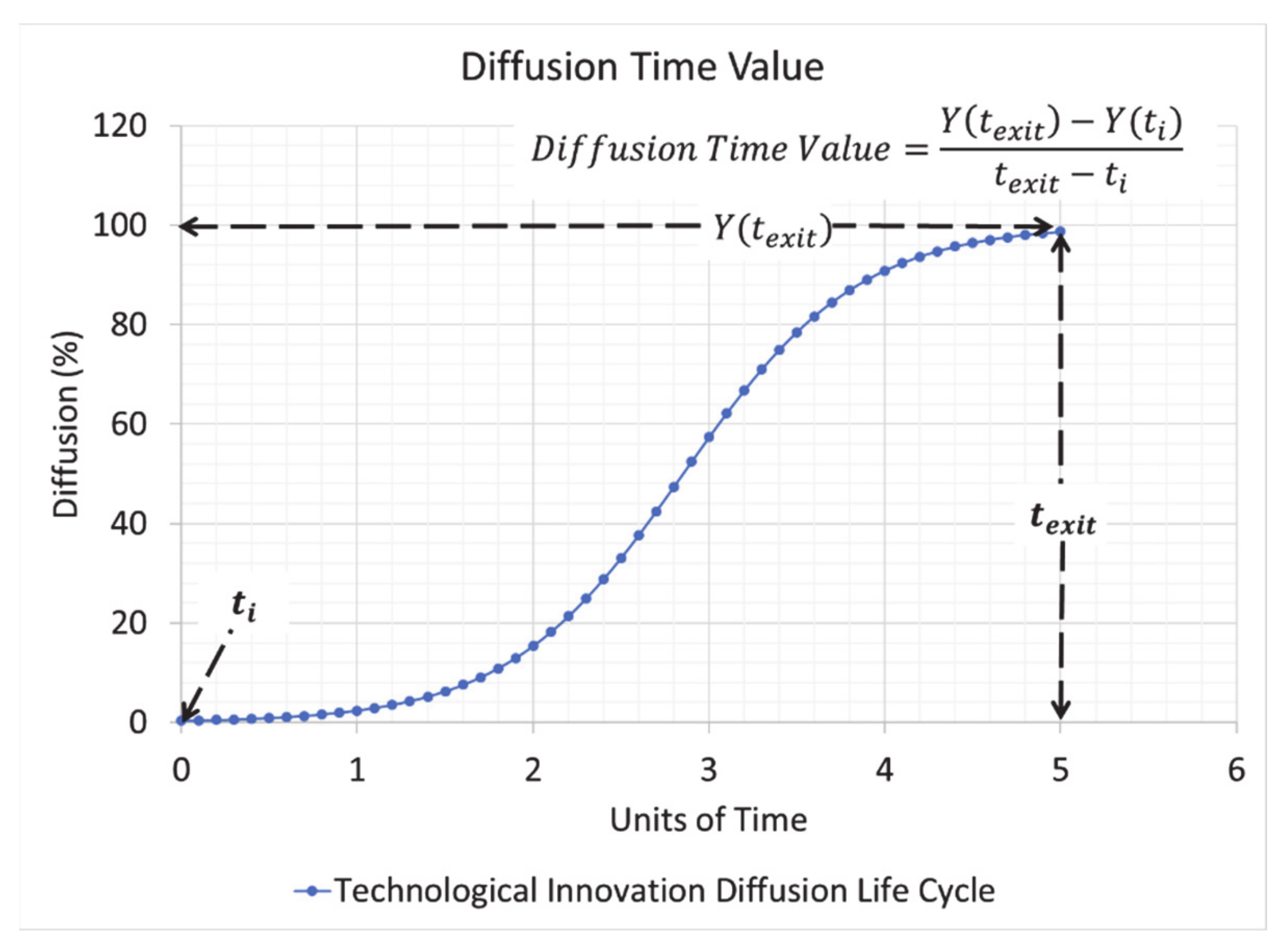

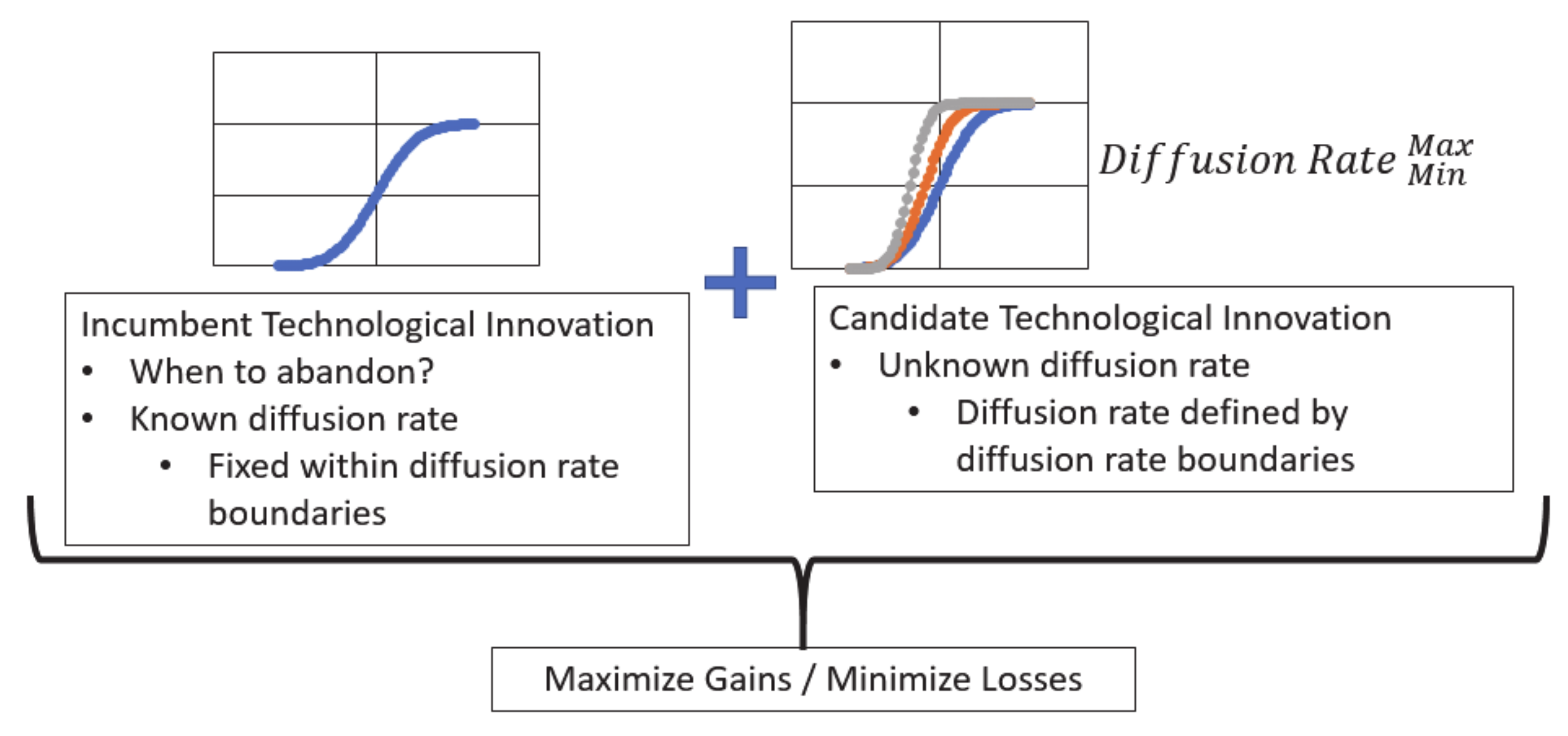

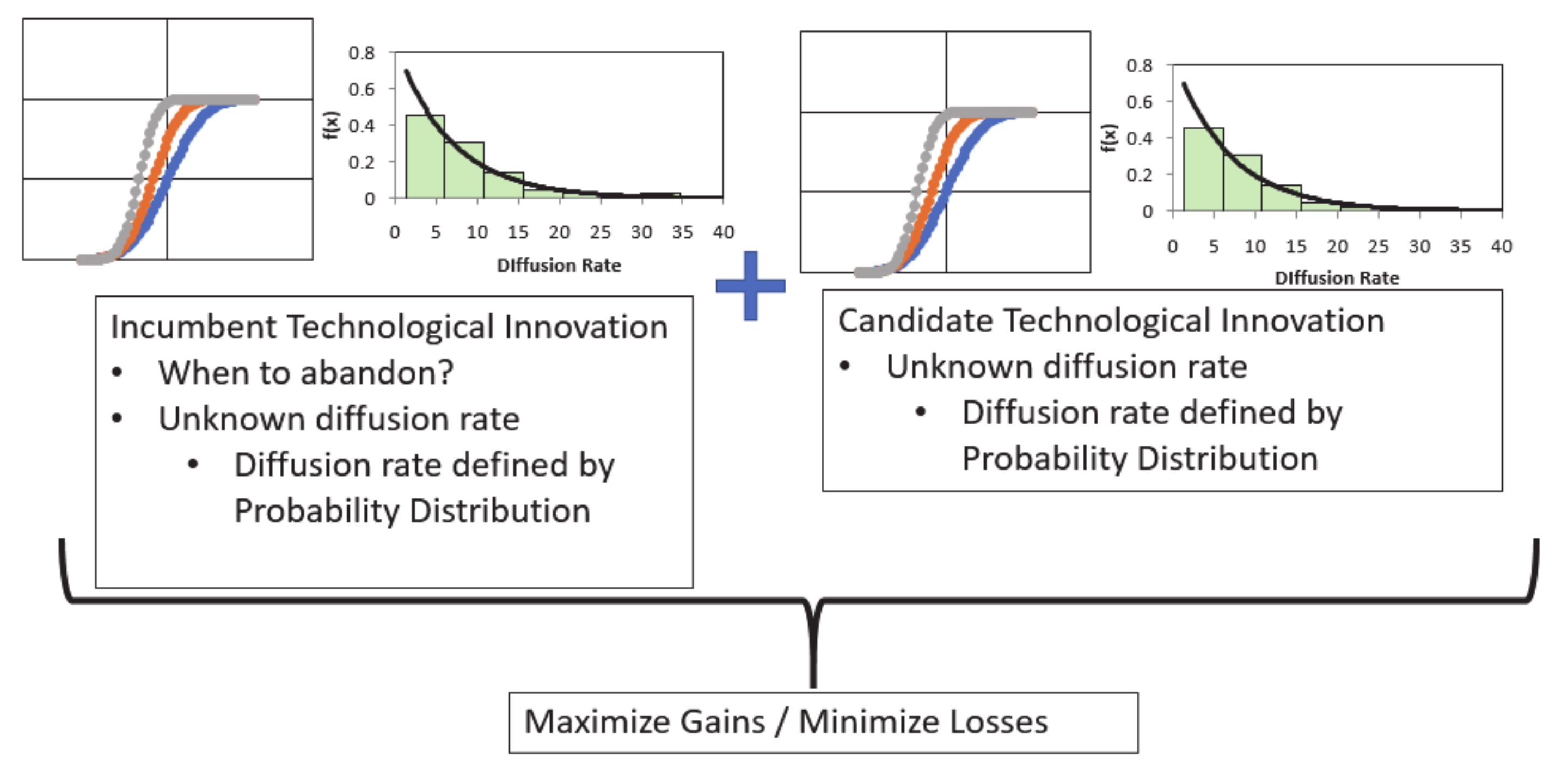
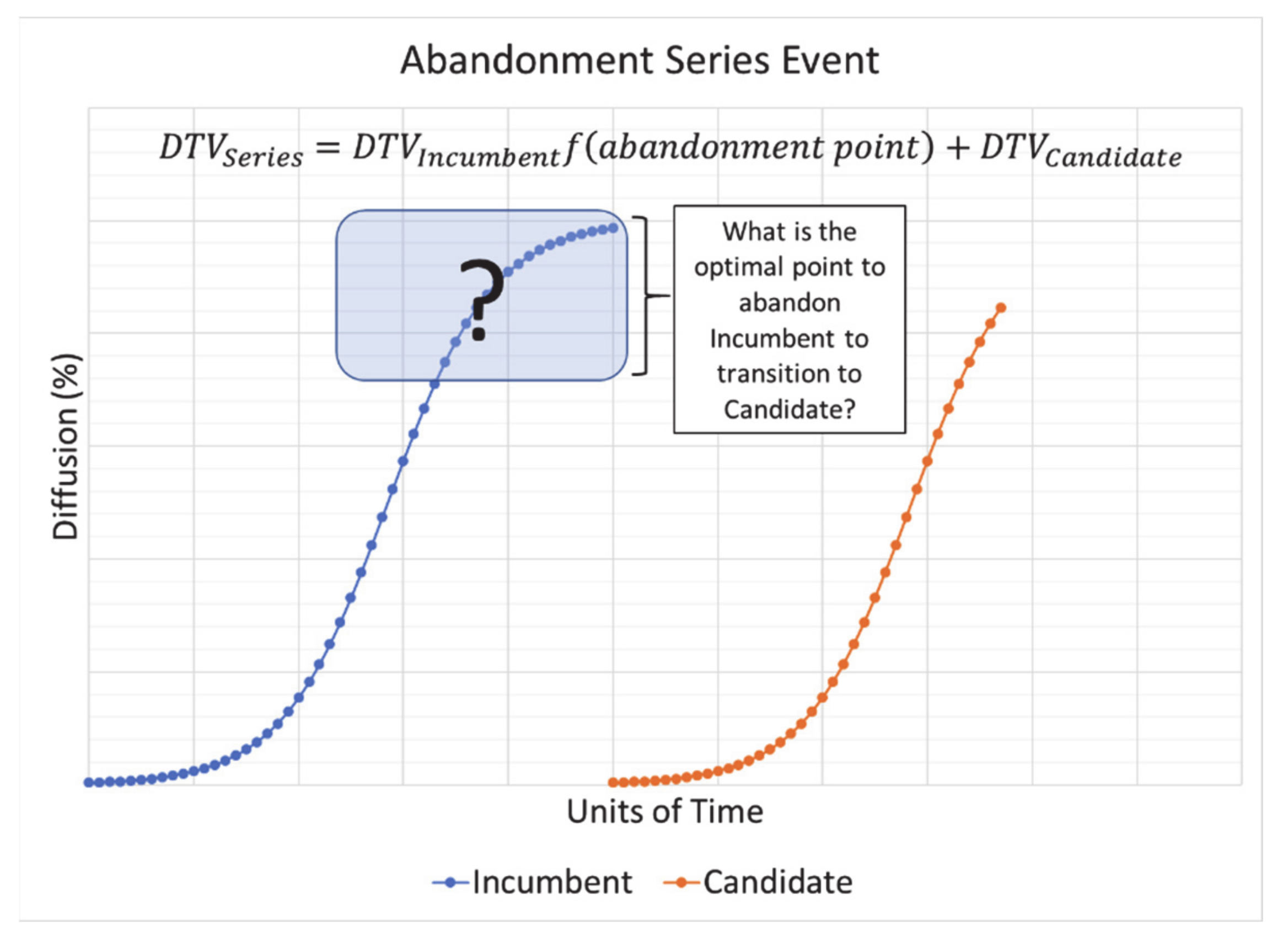
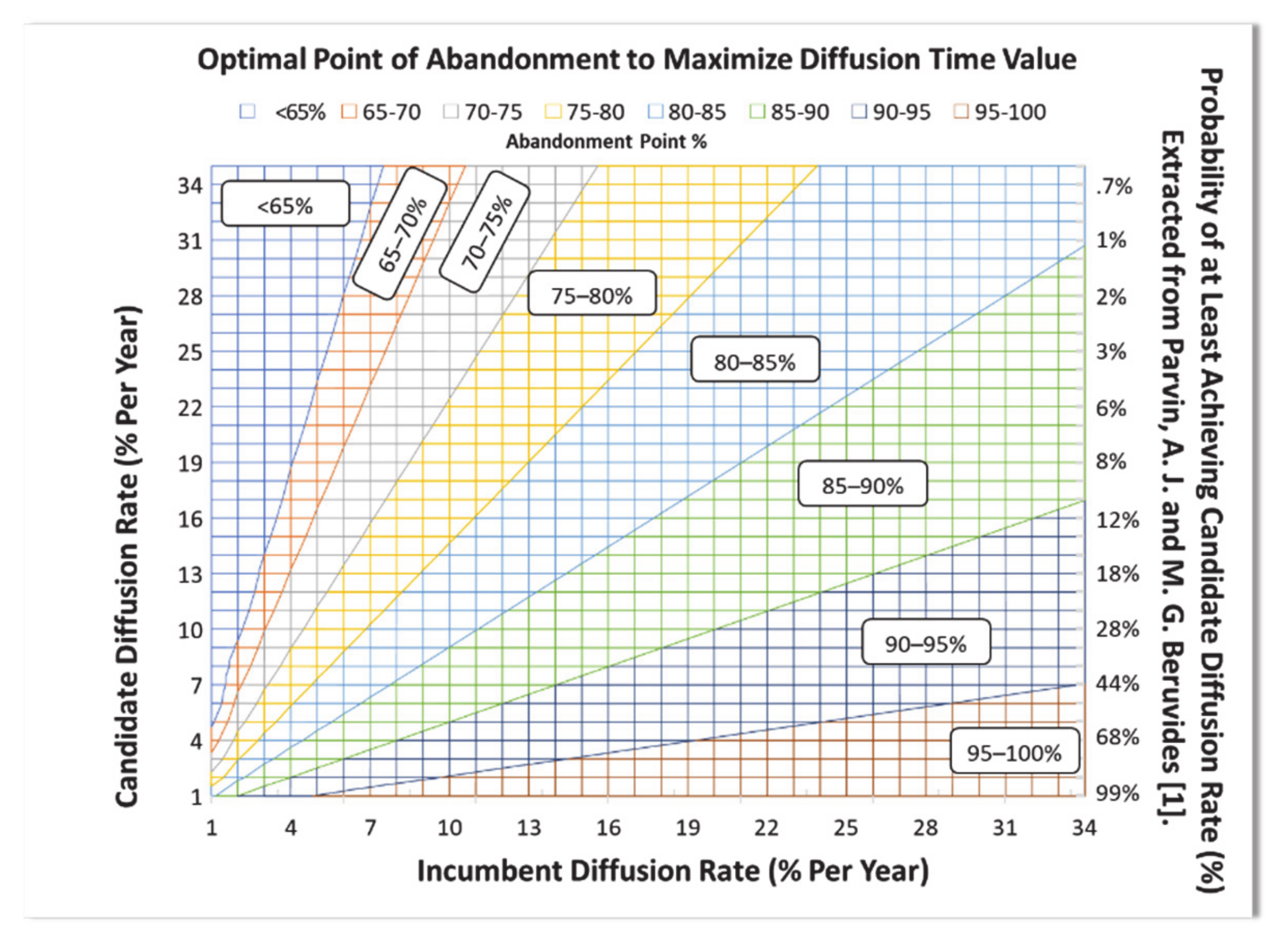
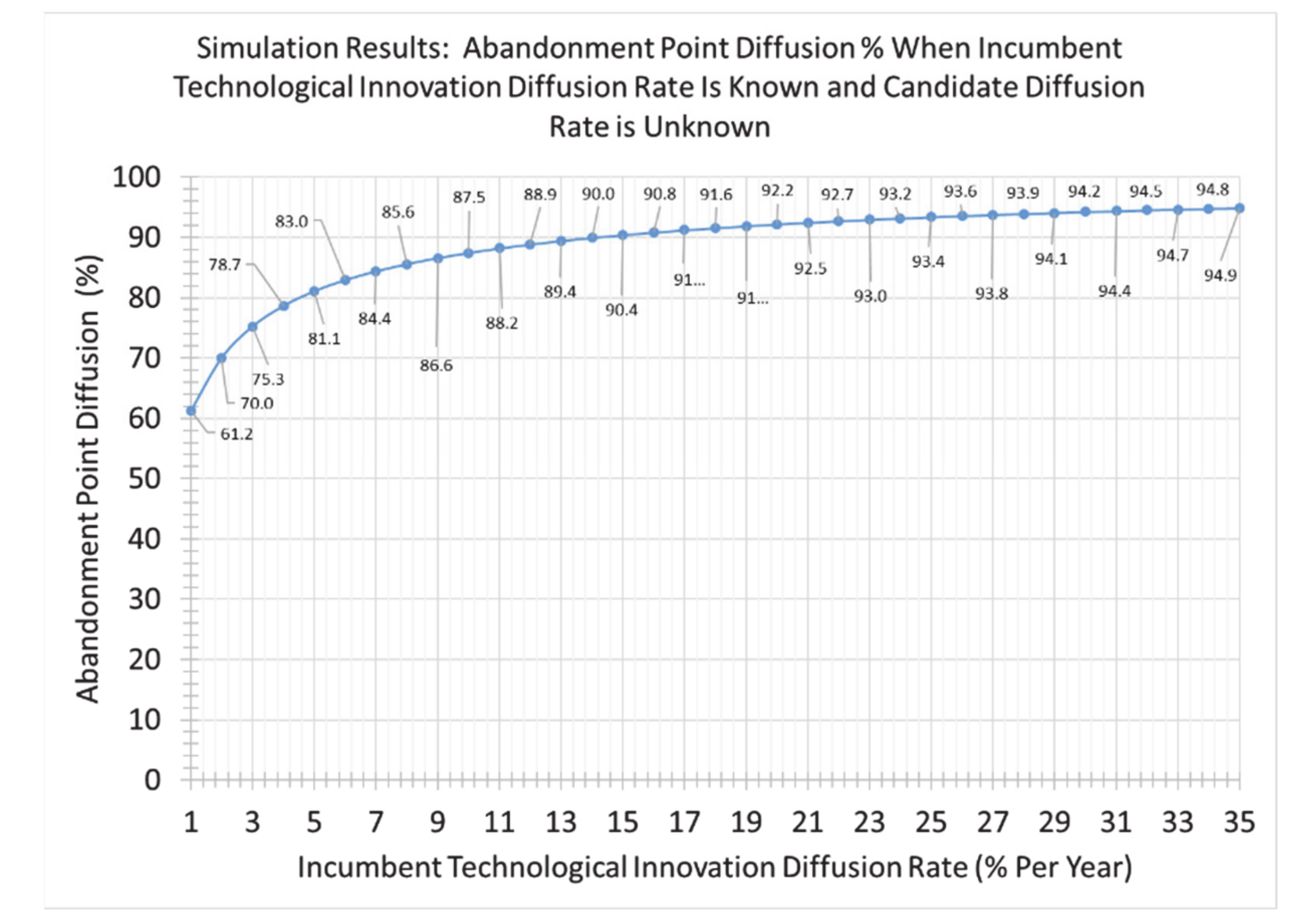
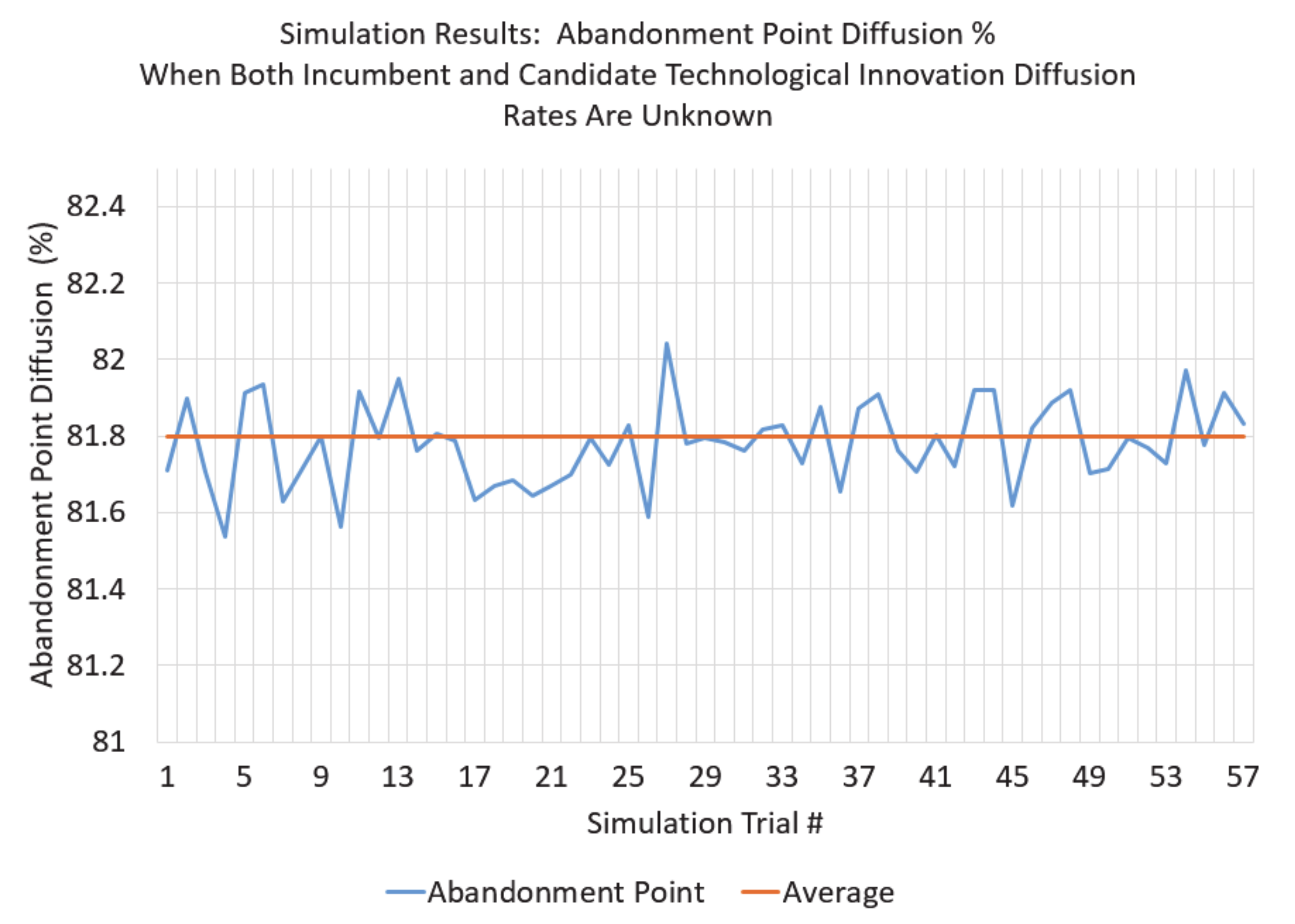
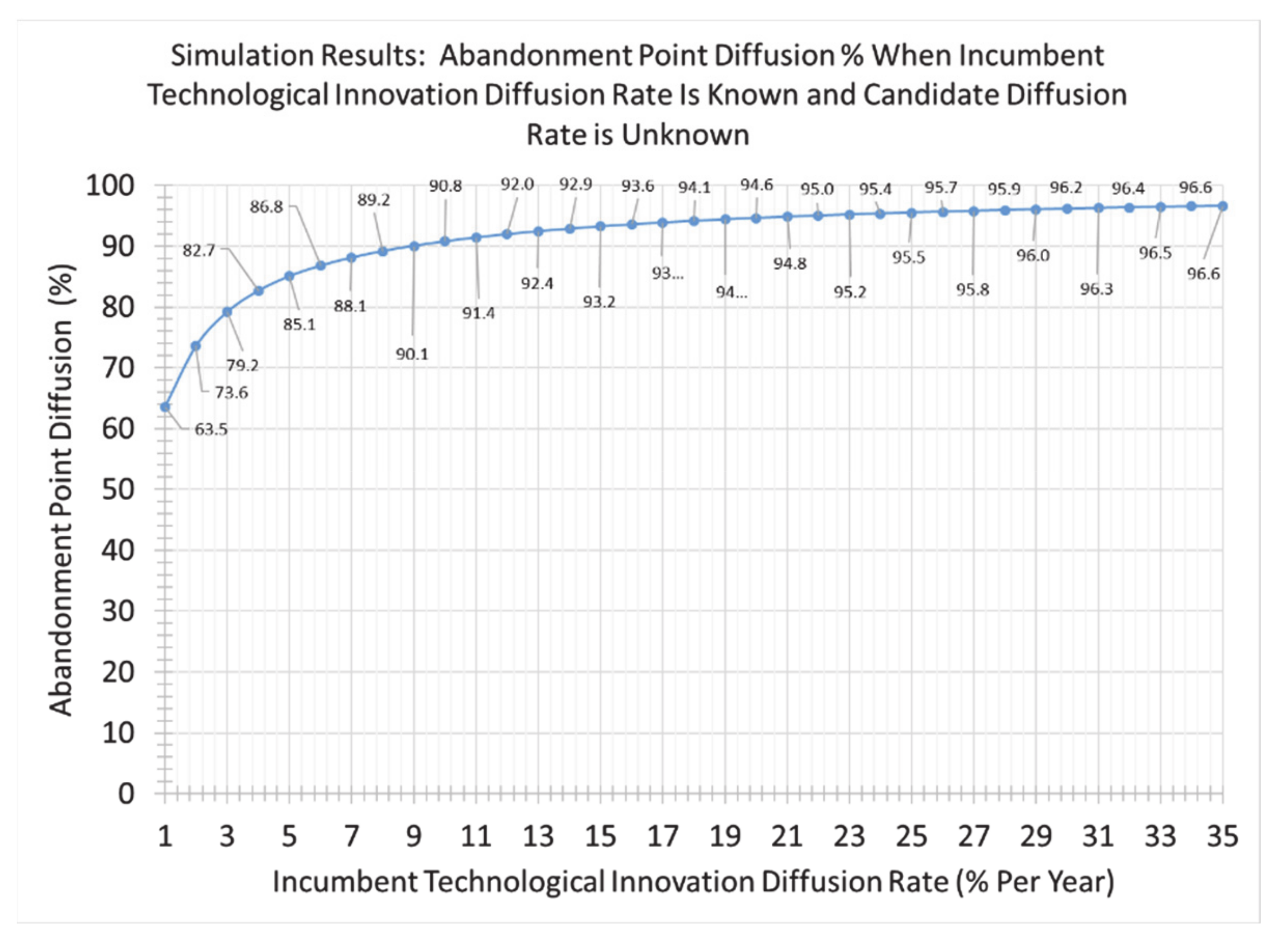
| 1. The maximum attainable diffusion (carrying capacity) of the incumbent is 100% |
| 2. The minimum attainable diffusion (carrying capacity) of the incumbent is 50% |
| 3. The candidate will not be abandoned before it reaches its optimal abandonment diffusion point for a singular event. 84% is the optimal diffusion point of abandonment for a singular event via DTV maximization analysis, using a logistic-based diffusion lifecycle |
| 4. The incumbent and candidate start at 1% diffusion |
| 5. One-year time intervals |
| 6. Diffusion rate range: 1.3 to 34.7 percent per year (approximated as 1 and 35%) |
| 7. There is no time delay between transitioning from the incumbent to the candidate |
| 8. The total market values of the incumbent and candidate are equal |
| Incumbent | Candidate |
| Diffusion rate % per year | Diffusion rate % per year |
| 1 | 1,2,3,…,35 |
| 2 | 1,2,3,…,35 |
| …. | “ |
| 35 | 1,2,3,…,35 |
Publisher’s Note: MDPI stays neutral with regard to jurisdictional claims in published maps and institutional affiliations. |
© 2021 by the authors. Licensee MDPI, Basel, Switzerland. This article is an open access article distributed under the terms and conditions of the Creative Commons Attribution (CC BY) license (https://creativecommons.org/licenses/by/4.0/).
Share and Cite
Parvin, A.J., Jr.; Beruvides, M.G. Optimizing the Abandonment of a Technological Innovation. Systems 2021, 9, 27. https://0-doi-org.brum.beds.ac.uk/10.3390/systems9020027
Parvin AJ Jr., Beruvides MG. Optimizing the Abandonment of a Technological Innovation. Systems. 2021; 9(2):27. https://0-doi-org.brum.beds.ac.uk/10.3390/systems9020027
Chicago/Turabian StyleParvin, Albert Joseph, Jr., and Mario G. Beruvides. 2021. "Optimizing the Abandonment of a Technological Innovation" Systems 9, no. 2: 27. https://0-doi-org.brum.beds.ac.uk/10.3390/systems9020027






